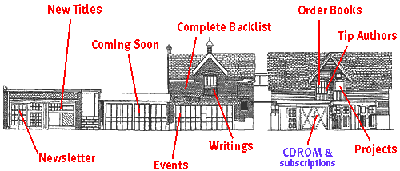 |
| "...not content to simply publish the fetish object known formerly as the book" Zsuzsi Gartner, George Straight |
| Coach House Online Editions. Image © Coach House Books. Reproduced by permission. |
The Canadian small press industry was largely born in the 1960's out of the rising nationalism of the times and a new focus by the federal and provincial governments on funding burgeoning Canadian culture. While most small publishers came and went, Coach House Press rose to be arguably the most important voice in the trade. Born in 1964 of the prevailing collective spirit of the era, Coach House was a true writers' press. It was run on a shoestring by owner Stan Bevington, who did not control, but was only one of a host of creative minds involved in the business. A number of Coach House's editors--who received no payment for their hard work--went on to achieve international fame, like Michael Ondaatje and bpNichol (also long-time President). The press's alumni of authors charted the rising hum of critical acclaim in Canadian publishing--with a list that included much women's writing, from Margaret Atwood's experimental fiction to leading lesbian writers like Daphne Marlatt, Gail Scott, Dionne Brand and Nicole Brossard (in translation). The press itself became as renowned for producing high quality, beautiful books, as it did for its unerring ability to identify fine (frequently new) writers and to predict important trends in literature. When Coach House closed its doors in 1996--the combined result of a change in administration, growing pains after trying to break into the American market and declining government subsidies--everyone thought it was for good.
Stan Bevington, however, has always been a visionary who combines traditional printing methods with state-of-the-art technology. It is no accident that he has been involved in software development with the Toronto-based company SoftQuad since the 60's. He resurrected the press in 1997 with a new name, Coach House Books, and a new mandate, to publish high quality, limited edition books that were also available free online prior to publication in book form. While a print run for a newly published book might be only 300 copies, the virtual press receives between 4,000 and 8,000 visits per week (Mandel). So far, that has not translated into major sales, but this has revolutionary implications for the future of publishing.
From its nineteenth century coach house on bpNichol lane in Toronto, Coach House Books now not only makes the books available online before they are published in paper and ink form, but it also sells annual subscriptions on CD-ROM (for the modest price of $25 Canadian). A subscription includes the year's entire list of 14 titles in 1997, and posters and other ephemera as well. The other change that has been implemented is a process of 'tipping' the author. Since the authors only receive royalties from book sales, any reader can pay a $3.00 tip directly to an author through the website. Based on the try-before-you-buy shareware system, Coach House has once again put its authors first.
The press marked its resurrection with a symphonic smorgasbord for the senses, Darren Wershler-Henry's Nicholodeonline, in tribute to and after the works of bpNichol. Respected for his online work and infamous for his part in Douglas Ruskoff's book Media Virus, it is unimaginable what form Wershler-Henry's resolutely electronic text might take as a 'fetish object' (i.e. book). Given Coach House's mandate, it is not surprising that most of the press's titles to date have been designed for more conventional publication--a number of them are re-issues of older books, like Douglas Clark's photographic icons, the beautiful and provocative Articles of Faith--but Patricia Seaman's gritty, satiric novel New Motor Queen City gains from its enactment of feminist theory in an electronic environment. It also links 'alternative' comic book publishing with Coach House's focus on works of art. All of these books possess the ability to exist outside of an electronic environment, but I cannot help but wonder what will be lost in the translation when Seaman's and Wershler-Henry's hypertexts are fixed on paper...

Carolyn Guertin